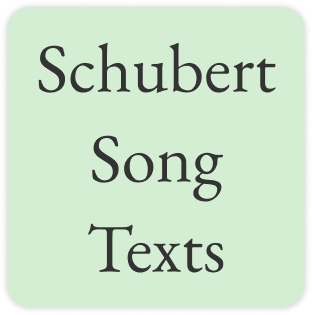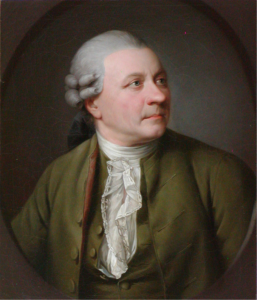The pink ribbon
(Poet's title: Das Rosenband)
Set by Schubert:
D 280
[September 1815]
Im Frühlingsgarten fand ich sie,
Da band ich sie mit Rosenbändern,
Sie fühlt’ es nicht und schlummerte.
Ich sah sie an, mein Leben hing
Mit diesem Blick an ihrem Leben,
Ich fühlt’ es wohl und wusst’ es nicht.
Doch lispelt’ ich ihr leise zu,
Und rauschte mit den Rosenbändern,
Da wachte sie vom Schlummer auf,
Sie sah mich an, ihr Leben hing
Mit diesem Blick an meinem Leben,
Und um uns ward Elysium.
I found her in the spring garden,
There I tied her with rose ribbons:
She did not feel it and carried on sleeping.
I looked at her; my life was hanging
On her life with that glance:
I felt it clearly and I did not know it.
But I whispered to her gently
And made a noise with the pink ribbons.
At that she woke up from her nap.
She looked at me; her life was hanging
On my life with that glance:
And around us everything turned into Elysium.
All translations into English that appear on this website, unless otherwise stated, are by Malcolm Wren. You are free to use them on condition that you acknowledge Malcolm Wren as the translator and schubertsong.uk as the source. Unless otherwise stated, the comments and essays that appear after the texts and translations are by Malcolm Wren and are © Copyright.
☙
Themes and images in this text:
Elysium Gazes, glimpses and glances Knots and bonds Ribbons Roses and pink Sleep Spring (season) Waking up Whispering
Informal English refers to couples getting married as ‘tying the knot’ or ‘getting spliced’, but the same textile metaphor is also used in the very formal 1662 Church of England wedding ceremony (the couple are ‘knitted together’). Other sets of imagery might be possible (the wedding service also refers to the couple being ‘joined together’, presumably like two pieces of wood with the vicar acting as ‘the joiner’), but the language of tying things together seems to be the basic way of visualising what is happening. Marriage is declared in legal terms to be a ‘binding contract’, which is a term based on the same cluster of imagery.
‘Red tape’, ‘being in a bind’, ‘dealing with a knotty problem’ tend to have more negative connotations but they use the same metaphor. It is all ‘bound up together’. Chemistry has adopted the language of ‘bonds’ to explain connections between different elements.
The past form and the participle of the English verb ‘to bind’ are ‘bound’, as you are bound to know. The German equivalent, ‘binden’, which is usually better translated just as ‘to tie’, uses ‘band’ for the past and ‘gebunden’ as the participle. ‘Ein Band’ can be a ribbon or a hairband, and ‘das Band der Freundschaft’ refers to the ties of friendship. Klopstock’s Das Rosenband refers to a bond that came about through a process of binding. The title refers to a single item (and we might suspect that this is a bunch of roses tied together), but the narrative makes clear that the girl was tied up (with pink ribbons?) in some way. The essential point, though, is that there were two loose ends that were tied here. Note the parallelism of stanzas 2 and 4. As the girl returns the writer’s look in stanza 4 the knot is tied.
☙
Original Spelling and notes on the text Das Rosenband Im Frühlingsgarten1 fand ich Sie, Da band ich Sie mit Rosenbändern: Sie fühlt' es nicht und schlummerte. Ich sah Sie an; mein Leben hing Mit diesem Blick' an ihrem Leben: Ich fühlt' es wohl, und wußt' es nicht. Doch lispelt' ich Ihr leise2 zu, Und rauschte mit den Rosenbändern: Da wachte Sie vom Schlummer auf. Sie sah mich an; Ihr Leben hing Mit diesem Blick' an meinem Leben, Und um uns ward Elysium. 1 Schubert changed 'Frühlingsschatten' (spring shadows) to 'Frühlingsgarten' (spring garden) 2 Schubert changed 'sprachlos' (without speaking) to 'leise' (gently)
Confirmed by Peter Rastl with Klopstocks Oden. Erster Band. Leipzig bey Georg Joachim Göschen. 1798, page 123.
First published in Lieder mit Melodien, für das Clavier, von Christian Ernst Rosenbaum. Zweeter Theil. Altona und Lübeck, Bey David Iversen, Königl. privil. Buchhändler aufs Herzogth. Holstein; 1762, page 6, with the title Das schlafende Mägdchen; then in Musenalmanach für das Jahr 1770. Göttingen bey Johann Christian Dieterich, page 68, with the title Das schlafende Mädchen; and in Poetische Blumenlese auf das Jahr 1774. Göttingen und Gotha, bey Johann Christian Dieterich, page 117, with the title Cidli.
To see an early edition of the text, go to page 123 [141 von 356] here: http://digital.onb.ac.at/OnbViewer/viewer.faces?doc=ABO_%2BZ223304809


